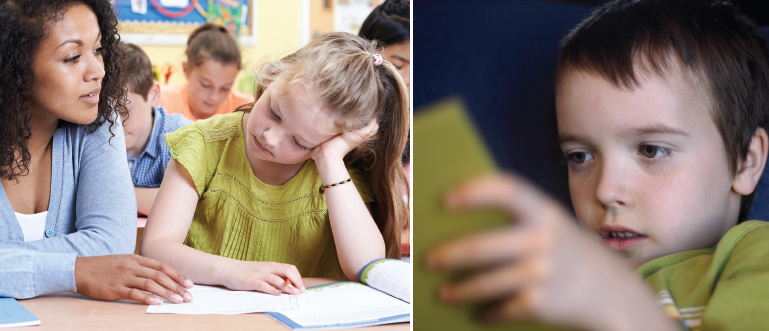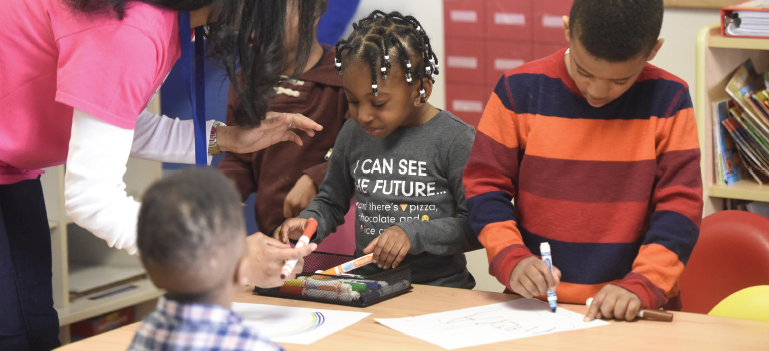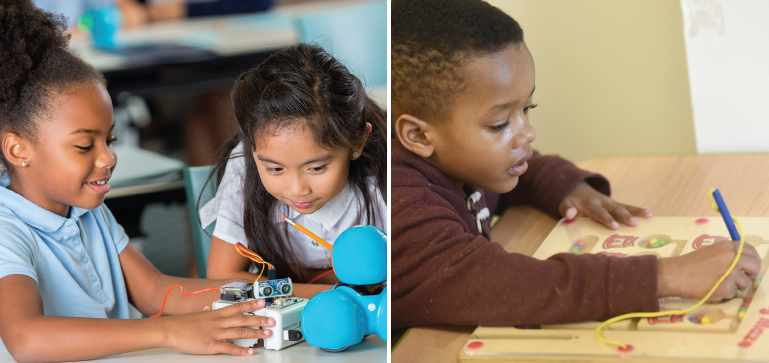12 Learning Disabilities
Ziad is a bright, athletic third grade boy who loves school, but his teacher, Mr. Washington, is unsure what to do about his learning disability. It seems that no matter what techniques he tries, Ziad still struggles with understanding what he reads.
Mr. Washington asks Mrs. Ellicott, the special education teacher who works with Ziad, for help. Mrs. Ellicott observes Ziad in class for a few days and then talks to Mr. Washington to outline some strategies that might work.
The first strategy the teacher tries is called pause-think-retell. Mr. Washington decides to use this with everyone in Ziad’s reading group. After a few scenes of the story, the group stops to think for a few minutes, and then they retell, in their own words or by drawing pictures, what happened so far in the story, details about the characters, or other information. Mr. Washington very much likes this strategy since he can monitor each child in the group and see how much detail each recalls. The first few times, no one in the group recalls much, so they reread the story and try the pause-think-retell strategy again.
After a few more weeks of using this strategy, Ziad’s comprehension starts to improve and he becomes more confident in his understanding of what he reads. Like Mr. Washington, Ziad likes the pause-think-retell strategy, and best of all, he know it’s working for him. He even starts to use it when reading his science textbook for homework. Knowing that he uses this strategy on his own makes Mr. Washington very proud of Ziad, and he tells him so.
Academic challenges and learning difficulties are common problems. Some academic challenges go hand in hand with intellectual, physical, or other identified disabilities. When a child who has no other identified disabilities has difficulty with reading, writing, spelling, and/or organizing or recalling information, however, he may have a learning disability. One in every seven Americans (15 percent) has a learning disability, and 8 to 10 percent of school-age children under the age of 18 have been diagnosed with a learning disability and receive special education services in school (NICHD 2017a).

What Are Learning Disabilities?
Learning disabilities are not a single disorder but more a general description of difficulties with processing certain kinds of information. There are several different types of learning disabilities, and many children have more than one.
» Dyslexia is a language-based disability in which a person has trouble understanding how speech sounds relate to letters and words.
» Dyscalculia is a mathematical disability in which a person has a difficult time understanding and solving arithmetic problems as well as understanding math concepts and learning math facts.
» Dysgraphia is a motor planning/writing disability in which a person finds it hard to recognize how to form different letters and to write words on paper.
» Nonverbal learning disability is a disorder in which a person finds it hard to interpret nonverbal communication; she may also have difficulty understanding how ideas relate to each other and generalizing a concept to different situations.
Researchers believe that people with learning disabilities have a neurological disorder in which the brain is wired a bit differently, causing trouble with processing, organizing, and interpreting the information they receive from their senses as well as recalling, organizing, and relaying information to others (Kane 2012). For example, when a child sees a word on a page, that information is relayed to his brain to see if the word has already been learned. If so, the brain instantly finds the word, and the child is able to read the word effortlessly. However, a child with a learning disability will see the word on the page, but his brain struggles to find the word in his memory (even if he has learned the word before), and he has difficulty reading the word. These same processing issues can happen when a child tries to understand math facts, process and express language, or engage in other areas of learning (Flink 2014).
As children start the primary grades, more of the information they learn comes through their eyes (reading a book, watching what the teacher is writing on the board) or through their ears (listening to the teacher give directions). The more information the brain is asked to process at the same time, the more noticeable it is when that process is not working correctly. These types of demands are why learning disabilities are often not diagnosed until a child is in the primary grades. There is usually a discrepancy between the child’s potential to learn and what she actually learns.
Possible Reasons for Learning Disabilities
The precise cause of learning disabilities is unknown, but heredity seems to be a factor. Other possible risk factors are exposure to drugs or alcohol during pregnancy, illness or injury before or during birth, or exposure to lead (NICHD 2017b).
Impact of Learning Disabilities on Development and Learning
Children with learning disabilities struggle with skills that affect them at school, at home, and in social situations. Reading, writing, and math may be difficult, as well as understanding what other people are saying. A child may have trouble with abstract reasoning and seeing the big picture. Weaknesses in visual and spatial perception may affect not only schoolwork but also coordination and participation in sports. Inside and outside of school, children may struggle with being on time, keeping organized, and having social interactions. Helping children develop the needed skills and strategies when they are young is essential.
When a child experiences frustration because learning is difficult and classmates seem to have an easier time, she may become depressed or angry. Common challenging behaviors include resisting doing homework or constantly asking for step-by-step help with homework that involves an area of difficulty, like math; showing excessive emotional reactions at school or home about homework or other challenging activities; and frequently misplacing or losing school books or other items to avoid homework (Mayo Clinic 2016c).
Facts about learning disabilities
• It’s estimated that 15 percent of the people in the United States have some sort of learning disability, but only 5 percent have been identified.
• Reading disabilities are the most common form of learning disabilities.
• Learning disabilities often occur in multiple members of the same family. (Cortiella & Horowitz 2014)
It’s important that children—and educators—understand that people who have learning disabilities are not dumb or lazy. Learning disabilities are not a reflection of a person’s intelligence or level of effort. Individuals with learning disabilities generally have average or above-average intelligence and often have to work much harder at tasks other people take for granted, like reading. They also have many strengths, often in areas not emphasized in academic settings. With the right support and encouragement to use their strengths as a foundation for learning, they can be successful both in and out of school (YCDC 2017).
Identifying Learning Disabilities
Diagnosing a learning disability is not an exact science; it’s a bit like putting together a complex puzzle. Some methods of diagnosing a learning disability rely heavily on the professional judgment of the person evaluating the child, and that naturally varies from professional to professional. In addition, states may have different criteria and standards for identifying and diagnosing learning disabilities in schools, and it is possible that a student would be identified as having a learning disability in one state but not another.
Dispelling the dyslexia myth
The misconception persists that dyslexia is characterized by letters and words appearing to reverse or switch places, and that this is responsible for reading difficulties. However, research shows that dyslexia is more about sounds than written letters. People with dyslexia have trouble discriminating basic sounds of speech, called phonemes, which are part of all spoken and written words (Mayo Clinic 2014b). This makes it difficult for an individual to connect letters and sounds to read a word.
Comprehensive Assessments
When evaluating a child for learning disabilities, professionals use both cognitive assessments and academic achievement measures. Cognitive assessments are commonly referred to as intelligence quotient (IQ) tests and measure thinking, problem-solving skills, and the child’s overall ability and potential to learn compared to other children the same age. Academic achievement tests measure the basic academic skills a child has compared with other children the same age.
A comprehensive assessment for learning disabilities should always include other sources of information, including informal classroom-based assessments, observations of the student in class, student self-reports if they are old enough, and parent accounts of the child’s functioning at home. If the multiple sources of information indicate that a student’s learning needs are not due to a vision or hearing loss, an intellectual disability, social-emotional difficulties, limited English proficiency, or a lack of opportunities to attend school or learn and the student is not achieving adequately for his age, then the IEP team can determine that there is a learning disability (NJCLD 2010).

Early Signs of Learning Disabilities
Teachers and families should be aware of some of the early signs of learning disabilities. The Learning Disabilities Association of America (LDA; 2017) and the National Association of Special Education Teachers (NASET; 2017) are among many organizations that have published lists of early symptoms of learning disabilities. Although most learning disabilities are not diagnosed until the child is in the early primary grades, it is always better to express concerns early than to wait.
Here are a few signs that a child may be at risk for a learning disability.
Preschool
» Struggles to pronounce words
» Repeatedly misidentifies common known sight words (classmates’ names, classroom labels)
» Doesn’t identify or recognize rhyming patterns in easy words like cat, bat, and rat
» Has difficulty with routines and following directions
» Has difficulty with small motor control like holding a pencil or zipping a jacket
» Has trouble sorting items by size, shape, or color, or repeating simple patterns
Kindergarten and First Grade
» Has difficulty associating written letters with sounds
» Has trouble segmenting words into syllables or clapping out syllables
» Exhibits challenging behavior or other kinds of avoidance (pretending to feel sick) when it is time to read
» Has difficulty with comprehension
» Consistently shows spelling or reading errors like letter reversals (b/d), inversions (m/w), transpositions (felt/left), and substitutions (house/home)
» Struggles with math concepts, such as greater than less than
» Has a hard time telling his left from his right and has a poor sense of direction
Second Grade and Up
» Reads aloud very slowly and awkwardly; often reads word by word with no inflection
» Makes wild guesses on unknown words to avoid having to sound them out
» Uses vague language such as “stuff” or “thing” a lot
» Needs extra time to respond to oral questions
» Can’t recall previously learned basic math facts, such as 2 + 2 = 4
» Has difficulty writing numerals in math problems, specifically putting them in the correct column
When considering whether a child’s difficulties may signal a learning disability, it’s important to take into account the opportunities he’s had to learn the skills in question. If a child has had little exposure to rhyming words—reading and sound play do not occur often at home, and he has experienced few group learning settings—it is unfair to assume that the child must be having difficult learning. However, if a child has had ample opportunities and still has difficulty, it is more likely that the problem is not due to lack of exposure.

Strategies for the Classroom
When a student is struggling, you do not need to wait for formal testing to confirm that current instruction is not working for this student. Even if a child has not been identified with a learning disability, consider what you can do now to support her. Keep in mind that no single method will help all students. Effective teaching requires intense, individualized methods that are beyond the scope of this chapter to address. Be intentional, systematic, and patient as you try strategies with a particular child.
Working with Strengths
Children with learning disabilities have many strengths that you can draw on in the classroom to help them experience success in learning and increase their self-esteem.
Preschool, Kindergarten, and First Grade
» Work with the child’s natural curiosity about new materials and concepts, and encourage her to figure things out for herself.
» Provide many opportunities for the child to use his imagination to design and create.
» Read aloud stories that are above children’s own reading levels. Most students with learning disabilities have a high level of understanding and a sophisticated listening vocabulary.
Second Grade and Up
» Learn what children are interested in and have them read about whatever it is. Reading confidence is buoyed by interest, motivation, and vocabulary words that are frequently practiced.
» Emphasize big-picture skills like reasoning, imagination, and abstraction rather than rote memorization of ideas and facts.
» Continue to read to children from books that are more difficult than they can read independently.
» Provide opportunities for children to find success in areas that do not depend on skills they have trouble with, such as visual arts, dramatic arts, or sports. Remind them that they are more than their ability to do classwork.
Tiered Systems of Support
In an effort to provide children with systematic, targeted interventions before they fall so far behind academically that they qualify for special education, many states and schools have developed tiered systems of support for K–12 programs. These systems are most commonly referred to as response to intervention (RTI) or multi-tiered systems of support (MTSS) programs (Samuels 2016). The programs are usually founded on
» High-quality, evidence-based curriculum and instruction at every level
» Ongoing assessment of students, including universal screening several times a year and progress monitoring
» Multiple levels, or tiers, of support and instruction with increasingly targeted interventions before a child is referred for a special education evaluation (RTI Action Network 2017)
While RTI programs are very popular in schools and many are implemented based on good intentions, there are some concerns about the model’s effectiveness. RTI has not been empirically validated; it is more of a theory that schools implement based on their own design than a model that identifies specific intervention (Sparks 2015). A recent study by the US Department of Education found that even when implemented as intended, many RTI programs do not reach the intended goals, and many students fall further behind their grade level rather than catch up (Balu et al. 2015).
It is important to understand that participating in tiered systems of support is not the same as, nor is it a substitute for, special education. Despite the shortcomings of some RTI implementations, the idea is built on designing teaching practices that give each child the support she needs to be successful at learning.
Working with Parents to Add Opportunities to Practice Skills at Home
Children from preschool through the early primary grades do well when they have repeated opportunities to practice skills they are learning every day. Encourage families to provide developmentally appropriate interactions and experiences that support the development of concepts and skills, such as
» Talking with their children about what they’re doing, what they like, and what they’re experiencing. Help parents understand how to ask higher-level questions that get children thinking, making connections, and using more complex language.
» Providing novel materials for children to explore, from everyday items like cartons and buttons, to objects they can take apart, explore, and use the parts to make new things. Exploring how things work stimulates conversations, collaboration, and problem-solving skills.
» Talking about simple chores the child can complete at home that involve early math skills, like setting the table for dinner and giving each person the correct place setting or matching and sorting the laundry.
» Reading aloud to their children, even when they’re in the early primary grades. Encourage families to do shared reading, where an adult reads aloud and children are actively involved in answering questions or predicting what will happen next.
» Allowing their children to tinker with open-ended materials and build in makerspaces. Spaces can be set up at home, and some communities and libraries host them. These spaces encourage creativity, problem solving, and innovation, which are often strengths of children with learning disabilities.
Summary
Because academic challenges and difficulty with learning are common, there is a lot of information and support available for families, teachers, and students. Diagnosing learning disabilities can be a long process, but parents and teachers who believe a child might be displaying early symptoms should seek more information and provide supports that are developmentally appropriate and tailored to the child.
Teachers and parents can help children with learning disabilities achieve by encouraging them to understand their strengths as well as their barriers to learning, and teaching them to speak up for what they need (LDA 2017). Although learning disabilities do not go away, every person with a learning disability can employ strategies that will help her succeed in school, develop friendships, and have a successful career in the future.